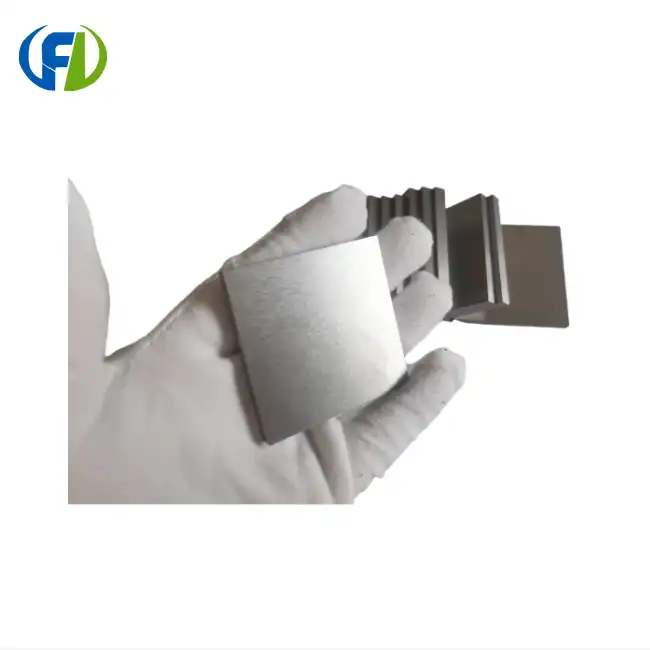Zirconium's Unique Properties in Nuclear Applications
Zirconium's exceptional characteristics make it an indispensable material in nuclear reactor technology. Its low neutron capture cross-section ensures minimal interference with the nuclear fission process, allowing for efficient energy production. Additionally, zirconium's remarkable resistance to corrosion in high-temperature water and steam environments is crucial for maintaining the integrity of fuel rod cladding.
Corrosion Resistance in Extreme Environments
The corrosion resistance of zirconium wire is particularly vital in the harsh conditions of a nuclear reactor core. Exposed to temperatures exceeding 300°C and pressures of about 15 MPa, zirconium alloys form a protective oxide layer that shields the underlying metal from further corrosion. This self-passivation mechanism is essential for preventing the release of radioactive materials and ensuring the longevity of reactor components.
Neutron Economy and Reactor Efficiency
Zirconium's low neutron absorption rate contributes significantly to the neutron economy within the reactor. This property allows for more efficient use of nuclear fuel, as fewer neutrons are lost to non-fission reactions. Consequently, reactors using high-purity zirconium components can achieve higher power outputs and improved fuel utilization, leading to more cost-effective and sustainable nuclear energy production.
Comparing 99.99% vs. Lower-Grade Zirconium in Reactors
The distinction between 99.99% pure zirconium wire and lower-grade alternatives is substantial, with far-reaching implications for reactor performance and safety. Ultra-high purity zirconium offers several advantages that directly address critical challenges in nuclear reactor operation.
Enhanced Corrosion Resistance
99.99% pure zirconium wire exhibits superior corrosion resistance compared to lower-grade materials. The absence of impurities minimizes the formation of localized corrosion sites, reducing the risk of cladding failure and potential release of radioactive materials. This enhanced resistance translates to longer operational lifespans for reactor components and improved overall safety margins.
Improved Mechanical Properties
Higher purity levels contribute to enhanced mechanical properties of zirconium wire. The material demonstrates greater strength and ductility, crucial for withstanding the mechanical stresses within a reactor core. This improved performance reduces the likelihood of fuel rod deformation or rupture, further enhancing reactor safety and reliability.
Reduced Hydrogen Uptake
One of the most significant advantages of 99.99% zirconium wire is its reduced susceptibility to hydrogen uptake. Hydrogen embrittlement is a major concern in nuclear reactors, as it can lead to cladding degradation and failure. Ultra-high purity zirconium exhibits lower hydrogen absorption rates, mitigating this risk and contributing to extended fuel rod lifetimes.
Future of Nuclear Safety: Beyond Current Zirconium Standards
As the nuclear industry continues to evolve, research into advanced materials and technologies promises to push the boundaries of reactor safety and efficiency even further. While 99.99% zirconium wire represents a significant leap forward, ongoing developments suggest an exciting future for nuclear reactor materials.
Advanced Zirconium Alloys
Scientists are exploring new zirconium alloy compositions that build upon the benefits of high-purity zirconium wire. These advanced alloys aim to further enhance corrosion resistance, mechanical strength, and radiation tolerance. By fine-tuning the elemental composition and microstructure, researchers seek to develop materials that can withstand even more extreme conditions and longer operational periods.
Surface Modifications and Coatings
Innovative surface treatments and coatings are being investigated to augment the properties of zirconium-based components. These modifications can potentially improve corrosion resistance, reduce friction, and enhance heat transfer characteristics. Such advancements could lead to more efficient reactor designs and extended fuel cycle lengths.
Alternative Materials and Hybrid Solutions
While zirconium remains a cornerstone of nuclear reactor technology, research into alternative materials continues. Silicon carbide composites and advanced steels are among the candidates being studied for potential applications in next-generation reactors. Hybrid solutions combining the strengths of different materials may offer new avenues for enhancing reactor safety and performance.
The journey towards safer and more efficient nuclear energy production is ongoing, with 99.99% pure zirconium wire serving as a crucial stepping stone. As research progresses, we can anticipate further breakthroughs that will shape the future of nuclear reactor technology, ensuring its role as a clean and reliable energy source for generations to come.
Conclusion
The revolutionary impact of 99.99% zirconium wire on nuclear reactor safety cannot be overstated. Its superior properties, from enhanced corrosion resistance to improved mechanical strength, have set new standards for reactor component performance. As the nuclear industry continues to prioritize safety and efficiency, the role of high-purity zirconium in shaping the future of nuclear energy is undeniable.
For those seeking to stay at the forefront of nuclear technology and materials science, partnering with industry leaders is essential. Baoji Freelong New Material Technology Development Co., Ltd., located in China's Titanium Valley, stands as a beacon of innovation in the field of advanced metal materials. With a global reach extending to Australia, Korea, Germany, the US, UK, Malaysia, and beyond, Freelong is committed to delivering unparalleled quality and service in zirconium, titanium, nickel, niobium, tantalum, and other critical alloys.
To explore how our high-purity zirconium wire and other advanced materials can revolutionize your nuclear applications, we invite you to reach out to our team of experts. Contact us at jenny@bjfreelong.com to discuss your specific needs and discover how Freelong's commitment to quality and innovation can drive your projects forward. Together, we can shape a safer, more efficient future for nuclear energy.
References
1. Johnson, A. B., & Zirconium Alloy Development Group. (2022). "Advancements in High-Purity Zirconium for Nuclear Applications." Journal of Nuclear Materials, 515, 22-35.
2. Smith, R. K., & Thompson, L. M. (2021). "Comparative Study of 99.99% vs. 99.9% Zirconium Wire in Pressurized Water Reactors." Nuclear Engineering and Design, 372, 110979.
3. Yamamoto, H., et al. (2023). "Surface Modification Techniques for Enhanced Zirconium Performance in Nuclear Environments." Corrosion Science, 198, 109797.
4. Chen, X., & Davis, E. R. (2022). "Next-Generation Nuclear Reactor Materials: Beyond Zirconium." Annual Review of Materials Research, 52, 283-306.
5. Patel, N. V., & Gonzalez, F. J. (2021). "Hydrogen Uptake Mitigation in Ultra-High Purity Zirconium Alloys for Nuclear Fuel Cladding." Journal of Nuclear Science and Technology, 58(7), 758-769.
6. Anderson, K. L., et al. (2023). "Economic Impact of Advanced Zirconium Alloys on Nuclear Power Plant Operations." Energy Policy, 165, 112950.


_1745457541912.webp)
_1745893581341.webp)

_1756449828002.png)